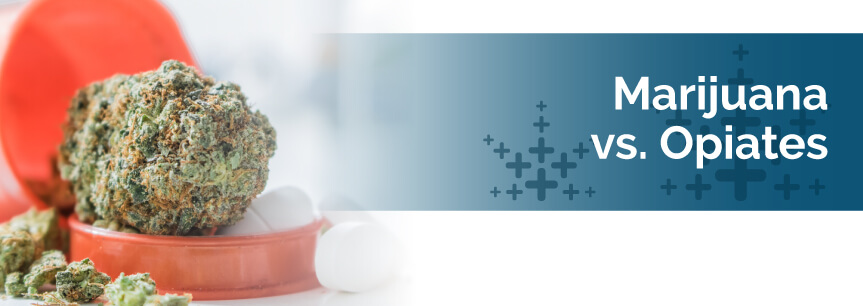
People who are experiencing chronic pain may go many years before finding relief, jumping from one painkiller to another. The pain can incapacitate at times and can affect all aspects of a patient’s life. Everyday simple tasks, like tying your shoes or buttoning your shirt, can be a struggle.
And, after years of dealing with physical pain, you find yourself starting to feel hopeless and depressed, thinking you’ll never get relief. However, hope for chronic pain is here, and it’s in the form of medical cannabis.
Chronic pain isn’t an isolated ailment. There are other symptoms many patients struggle with, either in addition to the pain or because of it. Some of these symptoms include:
Chronic pain is also a huge public health issue. In fact, it affects more than 100 million people in the U.S. alone, costing around $600 billion annually, according to The Institute of Medicine.
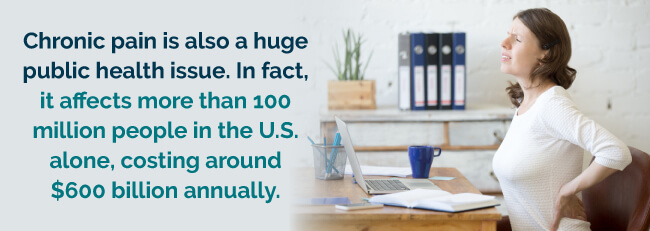
For most people, taking ibuprofen or acetaminophen is enough to help relieve common aches and pains. But when you’re suffering from chronic pain —
particularly when it’s more than mild — these over the counter medications just won’t cut it. In many cases, doctors will prescribe opiates for moderate or severe chronic pain.
Without giving it another thought, sufferers accept this prescription, since they’re willing to try just about anything to ease their pain and discomfort. Chronic pain management impacts around 11.2 percent of American adults, with around 3 to 4 percent of them prescribed long-term opioid therapy.

Opioids are a class of prescription pain medications that come from the poppy plant. Poppy extracts are the basis of narcotics like opium and heroin. Common opioid painkillers include Vicodin, morphine, OxyContin, Percocet and Zohydro.
Even if these painkillers do provide adequate pain relief, they also come with a whole range of adverse side effects. They can also be addictive and cause many people to abuse them.
Because opioids can be toxic, it’s not a surprise they can produce adverse reactions. And the side effects that go along with opioids can often be just as hard to manage as your pain itself. Some common side effects associated with opiates include:
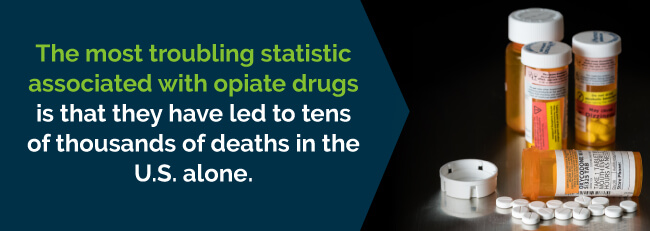
The most troubling statistic associated with opiate drugs is that they have led to tens of thousands of deaths in the U.S. alone.
Unfortunately, opioids are among the most abused pain medications, resulting in more than 183,000 people dying of an overdose of the drugs between 1999 and 2015.
In 2014, almost 2 million people in the U.S. were abusing or were addicted to opioid drugs, according to the Centers for Disease Control and Prevention (CDC). Estimates from the Kaiser Family Foundation show more than 21,000 died from overdoses in the same year.

JAMA Internal Medicine published a study that same year hinting that medical cannabis could reduce these troubling statistics. Researchers looked at death certificates in all U.S. states between 1999 and 2010. The annual rate of opioid painkiller overdose deaths, they found, was almost 25 percent lower in the states that legalized medical cannabis. That translated into more than 1,700 fewer deaths in 2010 in those states.
The new CDC report, published in February 2017, shows some compelling changes in two key areas: the drugs involved in the fatalities, and the age groups of the individuals affected the most.
For instance, although fatal overdoses involving “semi-synthetic,” “natural” and “synthetic” opioids — such as oxycodone, morphine and methadone — decreased between 2010 and 2015, the percentage of fatal heroin overdose cases tripled.
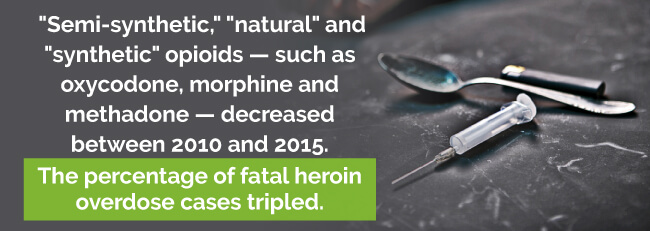
More precisely:
Twenty-nine percent of deadly overdoses in 2010 involved the so-called “semi-synthetic” and “natural” opioids, while 12 percent involved “synthetic” opioids. The percentage of deadly overdoses five years later involving opioids decreased to 24 percent and 6 percent, respectively. Heroin overdoses, however, jumped from 8 to 25 percent in 2010 to 2015. Various age groups suffered from deadly opioid overdose more than others. Although all age groups suffered an increase in overdose death rates, adults between the ages 55 and 64 showed the greatest increase. Among other age groups:
Additionally, opioids and heroin painkillers, including prescription painkillers, have a troubled relationship. According to research reported by the New York Times, because they act similarly in the brain, taking one — even if you take it as directed — can increase your susceptibility to getting addicted to the other.
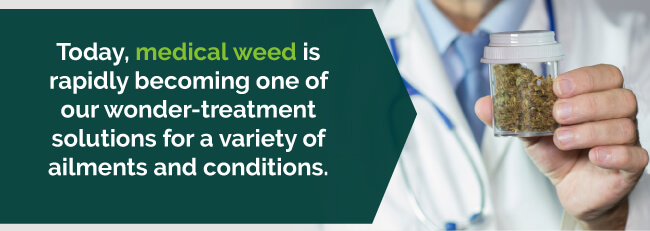
Today, medical weed is rapidly becoming one of our wonder-treatment solutions for a variety of ailments and conditions. Pot not only helps relieve chronic pain from a severe disease like multiple sclerosis or cancer, but many doctors now say it has a positive impact on people who are struggling with an opiate addiction.
So, marijuana vs. opioids? Which one is better for chronic pain? Both opioid and cannabinoid pain-relieving effects work by binding the receptors at your cells’ surface and setting off a series of events in your cell that leads to a pain blockage. The cannabis and parallel opioid mechanisms of action allow for efficient pain relief with co-administration.
Because of this, researchers theorize marijuana supplements opioids’ effectiveness in managing pain. When you use morphine and THC simultaneously, for instance, you get the same pain relief level at lower doses compared to if you were just receiving morphine alone.
Opiates and marijuana, however, prevent pain in different ways.
Opioid pain medication is a commonly prescribed drug today. Doctors prescribe them in various situations to help with moderate to severe pain. They block your brain’s pain signals. If you get cut, for instance, the nerves surrounding your injury send signals to your brain telling it that area of your body is hurt. After receiving these signals, your brain releases certain chemicals that notify you of your injury via the sensation of pain.
Opioids block neurotransmitters in your brain that inform you of your injury. The drugs keep you from feeling the full brunt of your injury by taking away your pain. Some instances where your doctor may prescribe you opioids include:
When taking opiates, it’s not uncommon to experience gastrointestinal problems like nausea, vomiting and constipation. However, the profound issues with taking opiate painkillers are dependence, addiction and overdose.
Researchers have yet to fully understand marijuana’s pain-blocking mechanisms. To begin with, elements in medical pot work with your opioid system and your endocannabinoid system. Your endocannabinoid system then interacts with different areas of your opioid system.
Prescription opioids, on the other hand, don’t engage with your endocannabinoid system like when you consume marijuana. Compounds in cannabis can:
Opioids and marijuana do similar things in your brain as far as blocking the signals of pain and causing you to feel good. However, cannabinoids such as CBD, CBC, CBN and THC also work methodically to decrease inflammation and relax damaged tissues in your body.
Medical cannabis is a safer option since it’s not physically addictive and there have been no reports of overdose deaths. Users also don’t build up their tolerance level of the drug like they do with opioids.
Not to mention, when patients use marijuana along with opioids, the weed prevents them from building up a tolerance and may help them wean off the opioids. So, essentially, patients would be reducing opioid dependence with marijuana.
Craving painkillers is a symptom of addiction and a huge cause of relapse. Unfortunately, treatments today are often ineffective at keeping patients from relapsing. Medical cannabis can play a key role here. Patients can use it to help them reduce their drug cravings effectively and their chance of relapse.
In fact, researchers are even studying cannabidiol, or CBD, to see if it is a potential addiction treatment. Both animal and human studies demonstrate CBD can reduce drug cravings and is non-addictive. It can also help treat withdrawal by reducing mood symptoms, pain and anxiety.

More than 75 percent of individuals addicted to opioids were able to wean off and replace opioids with marijuana. Furthermore, in states that have made medical pot legal, opiate overdose fatalities have decreased by 24.8 percent.
Since CBD helps treat withdrawal symptoms, prevents relapse and breaks the addiction cycle, it could help treat opiate abuse and addiction in the U.S., lower opioid prescription rates and reduce the risk of overdose.
So, what types of pain does medical marijuana treat? After all, there isn’t just one form of pain. Cannabis can soothe many types of aches and pains all sorts of medical ailments can cause, such as:

It seems cannabinoids tend to be most effective in pain conditions caused by central or peripheral nervous system damage. These pain conditions may include spinal cord injury, multiple sclerosis, diabetic neuropathy, HIV-associated neuropathy and post-traumatic pain following surgery.
Medical weed also has other benefits that improve patients’ well-being, such as alleviating stress or anxiety, improving sleep and reducing discomfort.
In a thorough, Harvard-led systematic review involving 28 studies, researchers examined the effectiveness of exo-cannabinoids — cannabinoids from the plant or synthetic formulations — in treating a variety of pain and medical problems. This review reveals high-quality evidence to back up the claim that using medical cannabis for neuropathic or chronic pain and multiple sclerosis-induced spasticity is effective.
Of all the reviewed studies, five out of five neuropathic pain studies and six out of six general chronic pain studies found substantial system improvement in patients. And, though most of the studies used synthetic cannabinoid preparations, three out of five studies involving neuropathic pain investigated smoking marijuana, and two studies investigated oral spray preparations.
In the 90’s, big pharma ensured the medical community that prescription opioids would not become addictive, however we now know this to be a lie. A study by the National Institute on Drug Abuse shows that abuse of opioids is the leading cause of death in the United States, with an estimated 90 deaths be day. Luckily for us, medical marijuana has been shown to be a real replacement for chronic pain treatment.
Reducing opioid use with marijuana and reducing the opioid pandemic in the U.S. are two huge benefits we’ve already pointed out. However, contrary to previous thinking, medical cannabis may have an even bigger role in controlling opiate abuse. Medical marijuana has at least three main potential uses:
Pot also has the benefit of being less addictive and dangerous than opioids.
The marijuana plant is the only one known to contain cannabinoid compounds. Your body naturally makes cannabinoids known as endocannabinoids to help ease pain. Neurologist and pharmacologist Dr. Ethan Russo performed research on endocannabinoids and came up with the theory that an endocannabinoid deficiency causes fibromyalgia, a disorder associated with fatigue and widespread pain.
A March 2016 study conducted by researchers at the University of Michigan and published in the Journal of Pain offers some intriguing information. Researchers found that marijuana:
Another study investigated marijuana and opiates and what patients prefer to manage their pain. Researchers found the patients preferred medical weed, and many said it was just as effective in treating their pain as opiates.
Patients involved in the study who were using marijuana and opioids reported the marijuana presented fewer side effects than their regular opiate prescriptions, and they were even able to use less of the opiates. The study may conclude that patients using medical weed report they can successfully use the weed along with opioid medications or as an alternative.
A report by The National Academy, reported that “In adults with chronic pain, patients who were treated with cannabis or cannabinoids are more likely to experience a clinically significant reduction in pain symptoms.”
Kent State University and University of California Berkeley researchers sent emails to survey participants asking them about their marijuana and opioid usage and their pain. Among the 2,810 survey participants who were using marijuana currently, in the last six months, 828 had used opioids to manage their pain.
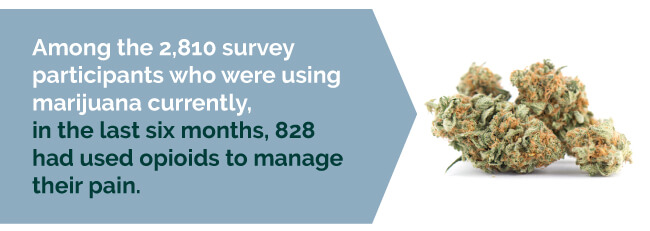
Ninety-seven percent of the sample from that group either agreed or strongly agreed they were able to reduce how many opiates they were taking when they also used medical pot. Additionally, 89 percent agreed or strongly agreed the opiates caused them unwanted side effects like nausea and constipation.
Most participants agreed they would choose marijuana over opioids to manage their pain.
There’s a good amount of research comparing the risks of various drugs, and by most calculations, cannabis is fairly low in risk and harm. In one particular study, researchers made a comparison of the overall risk of deadly overdose from a variety of drugs. Out of them, cannabis was the only one that fell into a “lower-risk” category.
Substances like Valium and amphetamines had a medium risk and alcohol, heroin and cocaine were all higher risks. When researchers ranked how addictive the drugs were, heroin and opiates were close to the top of the chart. They were above substances like ketamine, alcohol and benzodiazepines. Cannabis, psilocybin, LSD and other psychedelics were at the bottom of the chart, being far less addictive.
Using drugs in the “high-risk” category of causing addiction and overdose is risky. Cannabis is far less risky according to scientists, and you can use it to treat chronic pain, which is the biggest reason people turn to it medically.
As mentioned earlier, several studies show U.S. states allowing medical pot have fewer opiate deaths. In fact, according to Stat News, states that passed the laws experienced 20 percent lower opioid death rates during the first year, 24 percent in the third and 33 percent in the sixth.
Though you really can’t say fatalities decreased because the states legalized medical cannabis and not for any other reason, researchers in this case believe since this effect is getting stronger the longer cannabis is legal, it may just imply that it is a huge cause of the reduction in opioid deaths.
Now, this is not saying that cannabis has no risks itself. It’s just that from what researchers see so far, cannabis seems to be far less likely than opioids to harm users.
You can use many different types of marijuana strains to ease your chronic pain. To get an understanding of how certain strains affect you and the type of relief you can expect, you’ll want to learn about medical cannabis’ chemical compounds and strains. By knowing how your medical pot treatment works, it will make it easier for you to get through the “trial-and-error” phase and find the perfect strain and dose for you so you’ll find more relief.
There are three types of strains in marijuana plants: Indica, Sativa and hybrid. All of these relieve pain, but in different ways. For instance, Indica strains give you a deep, full-body effect, while Sativa strains get you energized and stimulate your senses.
Along with the strains, cannabis also contains cannabinoids. These compounds all serve their own purpose. For example, THC is the psychoactive compound that gives you the “high” you experience when using cannabis. It’s a powerful pain-relieving compound. CBD also offers you pain relief, but you don’t get the same high as you do with THC, because it’s not psychoactive.
Below are some of the most popular strains users say have effective pain-relieving qualities.
The strain you choose is a personal preference, but remember the outcome will depend on which strain you decide on and how much you consume. It’s a good approach to try out different strains and see which is better. You may go through a little trial and error with different strains, doses and which method you plan on using to get relief for your pain before you settle with the strain that’s perfect for you. If you’re using opiates currently, it’s important to be careful and consult with your doctor first.
When you’re first starting out with your medical cannabis treatment, begin slowly, using small doses, and work your way up to which dose works best to relieve your pain. Many patients report Indica strains seem to help alleviate their pain better than hybrids or Sativas, but again, your results will depend on trial and error and personal preference.
If you’re looking for a physician for marijuana for chronic pain, search for a doctor today. Here at MarijuanaDoctors.com, we’re your one-shop stop and directory to find locations, read reviews and locate dispensaries. You can also sign up for our free newsletter, where you’ll receive trusted information to keep you up to date on medical marijuana news, information and discounts.
No Information on MarijuanaDoctors.Com should be used to diagnose, treat, prevent or cure any disease or condition. You can view our Full Disclaimer here.